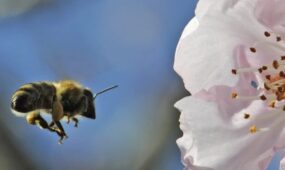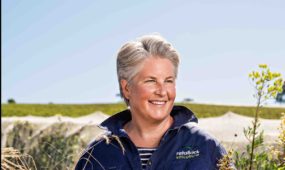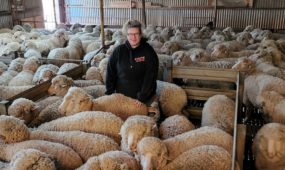Marginal lands have hope for growth with AusAgave
Primary Industries
AGAVE is usually considered a bit of a headache. It is painstakingly harvested by hand in countries such as India, Brazil and China to make low-margin products such as rope and carpet fibre. And Mexico uses the crop to make mezcal and tequila.

Sign up to receive notifications about new stories in this category.
Thank you for subscribing to story notifications.
Now, the same sugars that ferment so well in to alcohol have led to a resurging interest in the plant elsewhere in the world.
South Australian company AusAgave is pushing to revolutionise agave harvesting and processing of the drought proof plant, alleviating any headaches that tequila might cause.
They're aiming to assemble a waste free industry that turns the plant in to a full replacement biofuel, while using the leftover fibre in value-added products.
Don Chambers, CEO of AusAgave, imported his first agave plants to Australia ten years ago.
“The original plan was very simple. We were looking for crops that could be utilised in the arid Australian environment. That's how I came across agave, and the more I looked at it, the more I thought this could do something,” says Chambers.
In a joint effort with biofuel companies Byogy and Muradel, agricultural waste company GEN 2 Energy and the Waite Agricultural Research Institute at the University of Adelaide, AusAgave is realising the advantages of the resilient plant.
Unlocking marginal lands
Much of the potential of the hardy agave plant lies in the fact that it can unlock arid and marginal lands for commercial use. Of course, the meaning of 'arid' and 'marginal' depends on where you are.
“A lot of the literature that has come out of Mexico and Brazil says 'arid lands'. What they call arid land – well, they ain't seen nothing yet, not until they've seen the arid land in Australia,” Chambers explains. “So we prefer to call it marginal.”
“Agave will actually grow in the arid lands here, that's no problem, but it obviously performs better, as any plant does, with more rainfall and better soil.”
The company has been running trials of different varieties across Australia, including areas of the Northern Territory, Northern Queensland and more recently in South Australia.
“If you go to land near Alice Springs in Central Australia, or Whyalla or Port Pirie in South Australia, where each hectare is extremely cheap and there is marginal cropping, you don't have to have much of a yield to actually compete. Whereas if you grow it in Queensland where you're paying up to $20,000 a hectare, it's different,” Chambers says.
According to Chambers, they can compete at both levels. Their main competitor in the lush land of Far North Queensland is sugarcane, which is used in both sugar production and as a feedstock for bio-fuel.
Trials of agave have shown that yields of fibre and sugar in rainfall rich environments at least equal if not surpass the earnings potential of sugarcane.
Also notable is that there are no known pests or diseases that affect agave in Australia.
Unlocking potential with local partnerships
There have been challenges on the road to commercialisation. For a start, the crop needs to be cultivated – it won't go to seed in Australia. Harvesting needs to be made cost-efficient in places with high-cost labour.
There also needs to be the technology in place to make use of the fibres and sugars the agave plant produces, as well as an industry to support the supply lines needed. Finally, a customer is needed to purchase the end results.
AusAgave has initiated a number of partnerships in Australia and abroad to work through these issues. The first major hurdle of cultivating the plant was overcome with the help of the Waite Research Institute in Adelaide, South Australia.
“We started off at Waite testing how we could get rapid multiplication of the plant. You have to use tissue culture. We developed all of our protocols there. A number of students have done their PhD projects on it,” Chambers explains.
“Tissue culture is just taking a sample, usually a growing point of a plant. You put that in to a controlled atmosphere and it grows a number of leaves. Then you cut each of those growing points off. You go from one to five, then multiply those five by five, then again. It's a very rapid of way of multiplying, though a bit costly because of labour,” he says.
One distinct advantage of the tissue culture method is that plants are roughly the same age and fairly uniform in their growth, which opens the way for mechanical harvesting. Traditional planting and harvesting of agave results in uneven growth across a crop.
AusAgave received a $100,000 grant from South Australian business catalyst group BioSA in 2014 to develop fully costed drawings and plans for a mechanical harvester, plus additional support from the University of Adelaide, Whyalla Council and Regional Development Australia.
“No one else in the world has been able to mechanically harvest the thing,” says Chambers. “We need to prove we can harvest it efficiently. That will open it up to be a commercial crop on the broadacre scale. You could grow thousands of acres of it.”
Their partnership with South Australian company goes much deeper than just co-locating agave production. Muradel's technology converts algae in to green crude oil, effectively a full replacement for traditional fossil fuels.
Using its trademarked hydrothermal liquefaction technology called Green2Black, their trial plant in Whyalla, on the Eyre Peninsula in the northwest of South Australia, has the capacity to produce 30,000 litres of green crude per year that can be refined into petrol, diesel and aviation fuel.
Agave represents a good feedstock for Muradel because it is rich in the sugars and solids that can be mixed with the algae. AusAgave is trialling several varieties alongside Muradel's plant, with the first test results of the feedstock's effectiveness due by June 2015. Earlier results from overseas testing have been “exceptionally good”.
Unlocking additional markets with international partnerships
The problem with many first generation biofuels is that the end product is simply an additive like ethanol. For it to be a truly sustainable industry, biofuel needs to be full-replacement, like Muradel's technology.
“Many of the original biofuel technologies and companies really have not made it. You'd say the industry hasn't grown much, but that's because they needed higher prices,” Chambers says.
He says that what's happening now is that the remaining technologies are able to produce replacement fuels at basically fossil fuel prices.
“Your margins aren't there yet, so your sustainability becomes even more important,” Chambers adds. “You've got to make sure you can back it up.”
A strategic partnership with advanced biofuel company Byogy has resulted in Don Chambers taking a role in driving the company's feedstock operations. The aim is for agave to be integrated in to Byogy's supply line in making 100% replacement fuels.
AusAgave is also leveraging off Byogy's other contacts and partnerships. Byogy's subsidiary in Brazil has recently partnered with Avianca Brasil Airlines to provide higher blends of Byogy's fuel.
“We've been working with Brazilian companies – even the Brazilian government has been out to see the trials. They've sent a delegation (to South Australia) twice now and I've gone there. They're really keen to get this established in their drier areas,” Chambers says.
“They've got an ethanol economy. Their fuel uses so much ethanol that they need additional sources of it rather than just sugarcane,” he says. “We get calls from a lot of companies and individuals about agave.”
Conveniently, the supply chains for Byogy style fuel use the same technology and facilities as existing biofuel operations. Agave is interchangeable as a feedstock with sugarcane.
“To a large degree fibres are fibres, sugars are sugars. Once you get to the chemistry of it all, whilst there's differences, they're not significant differences.”
Byogy itself has found some synergy with GEN 2 Energy. The company is lending its expertise in advanced fermentation to the Byogy process. Likewise, a GEN 2 subsidiary, Agri Fiberboard, has unlocked value-adding opportunities for AusAgave.
“Byogy just uses the juice. In all of our modelling and working to date, we've been using the fibres as co-generation, burning it for heat and steam. We've always been looking for an area we can add value to the fibre.
“Agri Fiberboard looks to use agave fibre for MDF and fiber boards. So the three of us are now linked up. That's what gives us the supply chain. We can go from growing it in the ground to a finished product to fuel or timber or boards.”
The potential of a full, sustainable supply chain, Chambers says, is that it won't be subject to the rise and fall of oil prices – it can just keep operating through it all.
The next step
AusAgave's next step is to get production to commercial levels. As of now that depends on infrastructure availability in the more expensive cropping lands, alongside competitors like sugarcane.
Their current challenge is to hit critical mass in marginal lands, allowing for the construction of the necessary infrastructure to complete those supply chains – such as a Muradel style processing plant – to take their feedstock and produce fuel as well as any other value added products.
“That's what we're focusing on now. Working with regional groups or industries that have this infrastructure and then growing it. Once we get pretty good mass, we could say if you put in two million hectares you could put up to buy a refinery as well.”
AusAgave would then act as a service provider and licensee – servicing growers and appointing agents to sell their genetics and technology along with it.
“The whole thing is about a sustainable long-term crop. If you look at the aviation industry, defence, transport, they're all low margin end users. So you've got to have a sustainable crop grown in an area that's a lower cost. That's the benefit of using the agave.”
Jump to next article



